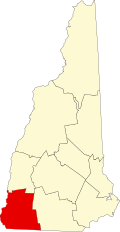Deacon Abijah Richardson House | |
 | |
| Location | 334 Hancock Rd., Dublin, New Hampshire |
|---|---|
| Coordinates | 42°54′42″N72°0′4″W / 42.91167°N 72.00111°W |
| Area | 2 acres (0.81 ha) |
| Built | 1818 |
| Built by | Richardson, A., Jr. |
| Architectural style | Cape Colonial |
| MPS | Dublin MRA |
| NRHP reference No. | 83004071 [1] |
| Added to NRHP | December 15, 1983 |
The Deacon Abijah Richardson House is a historic house at 334 Hancock Road in Dublin, New Hampshire. Built in 1818 by the son of an early settler, it is a well-preserved example of an early 19th-century Cape-style farmhouse. It was listed on the National Register of Historic Places in 1983. [1]


